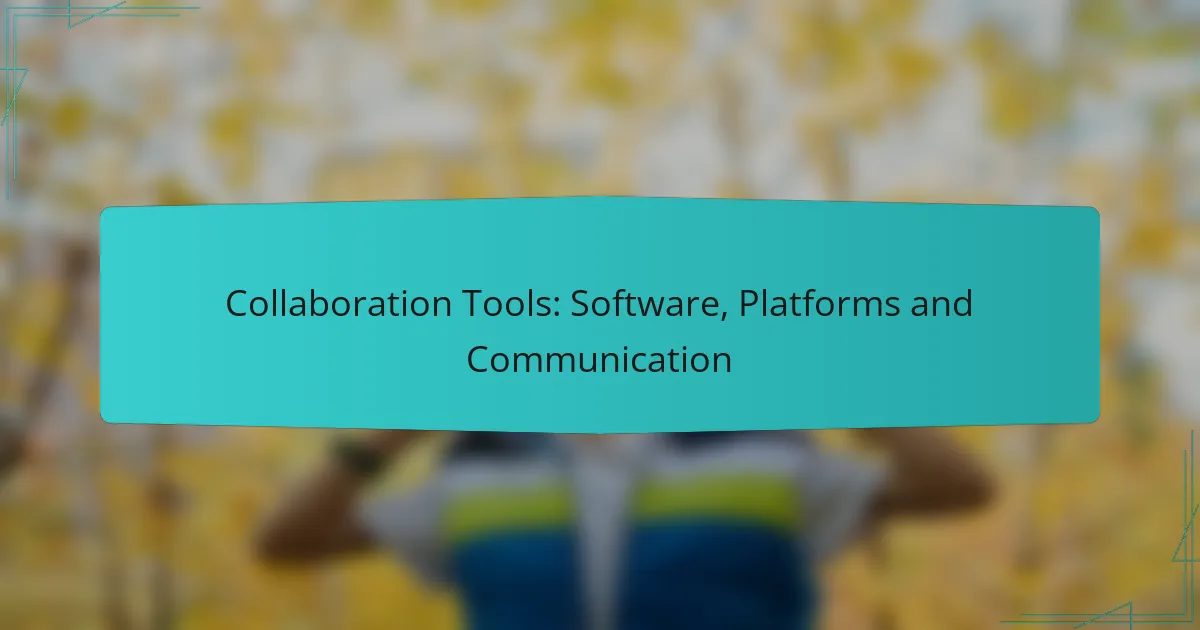Collaboration tools are essential for remote teams, as they enhance communication and streamline project management, fostering effective teamwork. With platforms like Slack, Trello, and Microsoft Teams, teams can interact in real-time, manage tasks efficiently, and access shared documents, ultimately boosting productivity and connectivity.

What are the best collaboration tools for remote teams?
The best collaboration tools for remote teams enhance communication, streamline project management, and facilitate seamless teamwork. Popular options include Slack, Trello, Zoom, Asana, and Microsoft Teams, each serving distinct purposes to improve productivity and connectivity among team members.
Slack for team communication
Slack is a messaging platform designed for team communication, allowing users to create channels for specific topics, projects, or teams. Its real-time messaging capabilities facilitate quick discussions and reduce email clutter, making it easier to stay connected.
Consider integrating Slack with other tools like Google Drive or Trello to centralize your workflow. Be mindful of notification overload; customize your settings to prioritize important messages and avoid distractions.
Trello for project management
Trello is a visual project management tool that uses boards, lists, and cards to organize tasks and workflows. Teams can easily track progress, assign responsibilities, and set deadlines, making it ideal for collaborative projects.
To maximize Trello’s effectiveness, establish clear board structures and use labels for prioritization. Regularly review and update boards to keep everyone aligned and accountable for their tasks.
Zoom for video conferencing
Zoom is a widely used video conferencing tool that enables virtual meetings, webinars, and screen sharing. Its user-friendly interface allows teams to connect face-to-face, which can enhance engagement and collaboration.
When scheduling meetings, consider time zone differences to accommodate all participants. Utilize features like breakout rooms for smaller discussions and recording options for those who cannot attend live sessions.
Asana for task tracking
Asana is a task management platform that helps teams organize and prioritize work. Users can create tasks, set due dates, and assign responsibilities, ensuring everyone knows their roles and deadlines.
To improve task tracking, break larger projects into smaller, manageable tasks and use Asana’s timeline feature for visual planning. Regular check-ins can help maintain momentum and address any roadblocks early on.
Microsoft Teams for integrated collaboration
Microsoft Teams combines chat, video conferencing, and file sharing into a single platform, making it a comprehensive solution for remote collaboration. It integrates seamlessly with other Microsoft 365 applications, enhancing productivity across various tasks.
Leverage Teams’ channels to organize discussions by project or topic, and utilize its file-sharing capabilities to keep resources accessible. Be cautious of information overload; establish guidelines for communication to maintain clarity and focus within teams.

How do collaboration platforms enhance productivity?
Collaboration platforms enhance productivity by streamlining communication and project management, allowing teams to work together more efficiently. These tools provide features that facilitate real-time interaction, centralized document access, and effective task management, which collectively reduce delays and improve workflow.
Real-time communication features
Real-time communication features enable instant messaging, video conferencing, and voice calls, which help teams stay connected regardless of location. This immediacy fosters quicker decision-making and reduces the time spent on emails or waiting for responses.
Platforms like Slack or Microsoft Teams offer chat functionalities that allow for quick exchanges, while tools like Zoom or Google Meet support virtual meetings. Utilizing these features can significantly cut down on project timelines and enhance team cohesion.
Centralized document sharing
Centralized document sharing allows team members to access, edit, and collaborate on files from a single location, minimizing version control issues. Platforms such as Google Drive or Dropbox provide cloud storage solutions that ensure all team members have the latest documents at their fingertips.
Using shared folders and real-time editing capabilities can streamline workflows and reduce the time spent searching for files. It’s essential to establish clear naming conventions and folder structures to maintain organization and accessibility.
Task assignment and tracking
Task assignment and tracking features help teams allocate responsibilities and monitor progress effectively. Tools like Trello or Asana allow users to create tasks, set deadlines, and assign them to specific team members, ensuring accountability and clarity in project roles.
Implementing a visual task board can enhance transparency and motivate team members by providing a clear overview of project status. Regular check-ins and updates on task progress can further improve team dynamics and keep projects on track.

What are the key features to look for in collaboration software?
Key features to consider in collaboration software include user-friendly interfaces, strong integration capabilities, and robust security measures. These elements ensure that teams can communicate effectively, share resources seamlessly, and protect sensitive information.
User-friendly interface
A user-friendly interface is essential for collaboration software as it facilitates easy navigation and quick adoption by team members. Look for intuitive designs that minimize the learning curve, allowing users to focus on their tasks rather than struggling with the software.
Consider features like customizable dashboards, drag-and-drop functionality, and mobile accessibility. These elements enhance usability and ensure that team members can collaborate efficiently, regardless of their technical skills.
Integration capabilities
Integration capabilities enable collaboration software to connect with other tools and platforms, streamlining workflows and enhancing productivity. Seek software that supports popular applications such as project management tools, file storage services, and communication platforms.
Assess the ease of integration and whether the software offers APIs or pre-built connectors. This flexibility allows teams to create a cohesive tech ecosystem, reducing the need to switch between multiple applications and minimizing disruptions.
Security and compliance
Security and compliance are critical features in collaboration software, especially for organizations handling sensitive data. Ensure the software adheres to industry standards and regulations, such as GDPR or HIPAA, to protect user information and maintain trust.
Look for features like end-to-end encryption, user access controls, and regular security audits. These measures help safeguard data and ensure that your collaboration efforts do not expose your organization to unnecessary risks.

How do pricing models vary among collaboration tools?
Pricing models for collaboration tools can differ significantly based on features, user limits, and payment structures. Understanding these variations helps businesses choose the right tool that fits their budget and needs.
Free vs. paid plans
Many collaboration tools offer free plans with limited features, making them suitable for small teams or individual users. These free versions often include basic functionalities, while paid plans unlock advanced features such as increased storage, enhanced security, and priority support.
For example, tools like Slack and Trello provide free tiers that allow basic communication and project management, but upgrading to paid plans can cost anywhere from $5 to $20 per user per month, depending on the features required.
Subscription-based pricing
Subscription-based pricing is common among collaboration tools, where users pay a recurring fee, typically monthly or annually. This model provides access to the latest features and updates without the need for large upfront investments.
Prices for subscription plans can vary widely. For instance, Microsoft Teams offers plans starting at around $5 per user per month, while more comprehensive packages can reach up to $20 per user per month, depending on the level of service and additional features included.
One-time purchase options
Some collaboration tools offer one-time purchase options, allowing users to buy software outright rather than subscribing. This can be appealing for organizations that prefer to avoid ongoing costs.
However, one-time purchases may come with limitations, such as fewer updates or support options. Tools like Microsoft Office traditionally offered this model, with prices ranging from a few hundred dollars for a single license, but many have shifted to subscription models for ongoing revenue and support.

What are the advantages of using cloud-based collaboration platforms?
Cloud-based collaboration platforms offer significant benefits, including enhanced accessibility, automatic updates, and scalability. These features enable teams to work together efficiently, regardless of their physical location or size.
Accessibility from anywhere
One of the primary advantages of cloud-based collaboration platforms is their accessibility from any location with internet connectivity. This allows team members to work remotely, access files, and communicate in real-time, which is particularly valuable in today’s flexible work environments.
For example, a team member in New York can easily collaborate with colleagues in London or Tokyo without any geographical barriers. This capability fosters inclusivity and ensures that all team members can contribute effectively, regardless of where they are based.
Automatic updates
Cloud-based platforms typically provide automatic updates, ensuring that all users have access to the latest features and security enhancements without manual intervention. This reduces the burden on IT teams and minimizes downtime associated with software updates.
With automatic updates, teams can focus on their projects rather than worrying about version control or compatibility issues. This is especially important for organizations that require consistent performance and security across their operations.
Scalability for growing teams
Scalability is a key advantage of cloud-based collaboration tools, allowing organizations to easily adjust their resources as their teams grow. Companies can add or remove users and features based on their current needs without significant upfront investments.
For instance, a startup can begin with a basic plan and upgrade to a more comprehensive package as they expand, accommodating new team members and projects seamlessly. This flexibility helps organizations manage costs effectively while ensuring they have the necessary tools to support their growth.

What are the challenges of implementing collaboration tools?
Implementing collaboration tools can be challenging due to factors like user resistance, integration issues, and varying levels of digital literacy among team members. Organizations must navigate these obstacles to ensure successful adoption and effective use of the tools.
User Resistance to Change
User resistance is a common challenge when introducing new collaboration tools. Employees may be accustomed to existing workflows and hesitant to adopt unfamiliar systems. To mitigate this, organizations should involve team members in the selection process and provide adequate training to ease the transition.
Encouraging feedback during the implementation phase can also help address concerns and increase buy-in. Highlighting the benefits of the new tools, such as improved communication and efficiency, can further motivate users to embrace the change.
Integration with Existing Systems
Integrating new collaboration tools with existing systems can pose significant challenges. Compatibility issues may arise, leading to disruptions in workflows and data management. Organizations should conduct thorough assessments of their current infrastructure before selecting collaboration tools to ensure seamless integration.
Choosing tools that offer robust APIs or built-in integrations can simplify this process. Additionally, involving IT teams early in the implementation can help identify potential issues and streamline the integration process.
Varying Levels of Digital Literacy
Varying levels of digital literacy among team members can hinder the effective use of collaboration tools. Some employees may struggle with new technologies, leading to frustration and decreased productivity. To address this, organizations should provide tailored training sessions that accommodate different skill levels.
Creating user-friendly guides and resources can also support employees as they navigate new tools. Pairing less experienced users with tech-savvy colleagues for mentorship can foster a collaborative learning environment and enhance overall tool adoption.



